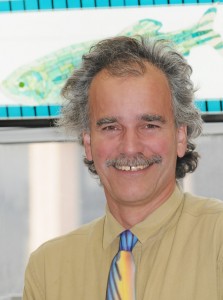Devoto’s Study Contributes to the Understanding of Birth Defects, Muscular Diseases

Professor Stephen Devoto and his students have identified a gene that controls a critical step in the development of muscle stem cells in vertebrate embryos. This discovery will allow scientists to better understand the causes of birth defects and diseases affecting human musculature, such as Muscular Dystrophy, and opens doors for the development of effective stem cell therapies for such diseases. Devoto is professor of biology, professor of neuroscience and behavior.
The study, “Fss/ Tbx6 is required for central dermomyotome cell fate in zebra fish,” was published in July in Biology Open. Though the research was done on zebrafish, the gene, known as Tbx6, exists in all vertebrates, including humans. The lead author was graduate student Stefanie Windner. Other co-authors, all part of Devoto’s lab, were Devoto, post-docs Nathan Bird and Sara Patterson Ph.D. ’08, and lab manager Rosemarie Doris. Funding was provided, in part, by the National Institutes of Health’s (NIH) Eunice Kennedy Shriver National Institute of Child Health & Human Development.
A number of undergraduate students also assisted in the research, and are extending this work further.
“Chantal Ferguson ’13 and Jaewon Chung ’13 are deeply involved in every step of research—from grant writing to discussing theories and models to doing experiments,” Devoto remarks. “They’re working side-by-side with graduate students and post-docs, part of the kind of research group typically seen only at research universities.”
For this paper, members of Devoto’s lab studied a mutant strain of zebrafish, which were missing a functional copy of the gene Tbx6. They observed that the embryos of these mutant fish had a defect in the dermomyotome—a tissue comprised of stem cells that can give rise to muscle fibers. These stem cells can either proliferate into other dermomyotome cells, or differentiate into muscle cells—which, themselves, cannot divide further. Thus, when the stem cells develop into muscle, they hit a dead end of sorts, precluding any additional muscle fibers from developing in the future. The group concluded that Tbx6 functions as a key part of the mechanism which either triggers the development of the dermomyotome, or inhibits the development of muscle.
“Tbx6 is a critical component of the switch that regulates the proportion of embryonic cells that become stem cells as opposed to muscle fibers,” explains Devoto.
The group confirmed that Tbx6 was responsible for dermomyotome development by injecting the mutant fish with DNA they had constructed containing the Tbx6 gene, and activating the “transgene” with a shock of heat. Activation of the transgene completely restored the dermomyotome.
This study also, for the first time, identified a genetic link between the “segmentation” that occurs in the embryos of all vertebrates, and the development of muscle tissue. Embryos defective for Tbx6 not only have defects in the development of muscle stem cells, they also have a loss of repeated segments that later give rise to the individual, repeated vertebrae that characterize vertebrates. Devoto is excited about this: “It appears that this one gene plays a central role in two of the characteristics important for vertebrates—the formation of vertebrae, and the ability to grow large amounts of muscle after birth.”
Devoto says future research will focus on understanding the exact mechanism by which Tbx6 acts to either trigger the development of dermomyotome or inhibit muscle development. His lab is testing certain proteins, which are known to interact with Tbx6, for involvement in dermomyotome development. It also is collaborating with a group of scientists in London to identify the target genes that Tbx6 activates.
“As a long-term goal, my research seeks to contribute to understanding birth defects and diseases affecting human musculature, and developing therapies for them. The gene we identified plays a critical role in the fundamental decision a cell makes between proliferation and differentiation. If we can understand how an embryo does that naturally, we’ll be better equipped to get stem cells in clinical treatments to behave as we want them to,” says Devoto.

